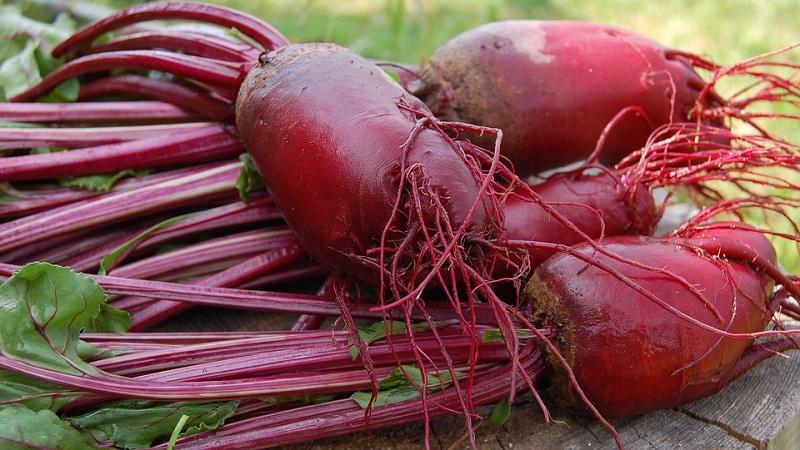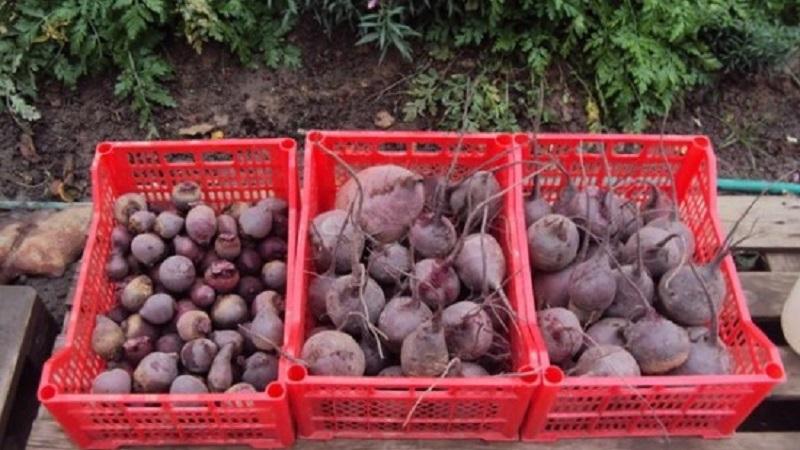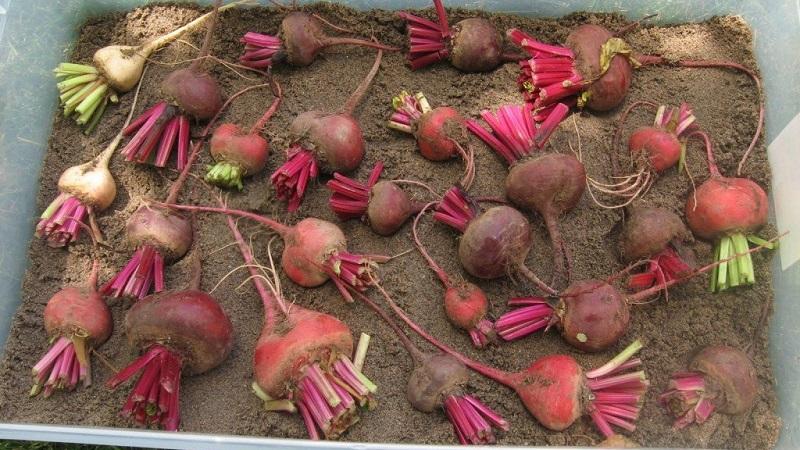Fresh vegetables all year round - how to store beets in a cellar in winter: create ideal conditions and avoid product spoilage
Beetroot is one of the most valuable and healthy vegetables with a unique composition of minerals and vitamins. It is always more pleasant to eat vegetables grown on your site. Gardeners always know what and how the plant was fed, how the roots were collected from the garden, which variety tastier, which is stored longer in the winter in the cellar.
Consider how right to grow, collect and preserve the beet harvest at home for the whole winter.
The content of the article
- Varieties suitable for long-term storage
- How to properly grow and prepare crops for long-term storage
- Preparing the cellar for winter storage of vegetables
- How to store beets in a cellar in winter
- Successful neighborhood
- How to save a "sick" crop
- Shelf life of beets in the cellar
- Little tricks for keeping a big crop
- Conclusion
Varieties suitable for long-term storage
Breeders distinguish beet varieties that differ in taste and shelf life. As a rule, these are late-ripening varieties that give a harvest in late summer - early autumn:
- Egyptian flat;
- Bona;
- Cylinder;
- Renova;
- Detroit.
One of the main characteristics of such varieties is excellent keeping quality during storage.
Reference. Keeping quality is the ability of vegetables to maintain all their qualities for a certain time. This is a characteristic of a particular variety. It is associated with the peculiarities of the structure and composition of the fruit.
There are 3 types of vegetables: with long, medium and short shelf life. Beets are of the first type.

How to properly grow and prepare crops for long-term storage
Beets like black earth, loamy, sandy loam soilrich in organic matter. The beds begin to be prepared in the fall. Choose a place where carrots, beets and other root crops did not grow in the previous season. Sowing begins in spring, when the temperature of the earth at a depth of 10-15 cm has reached + 10 ° C.
Important! Leave the distance between the seeds 4-5 cm, between the rows - 20-25 cm. Sowing depth - 2.5-3 cm. To feed the seedlings, use mullein or bird droppings diluted with water 1:10.
The beds with young shoots are thinned out 2 times:
- Primary thinning - when the first true leaves appear. The distance between the "tails" is 9-10 cm.
- Secondary - with a leaf height of 7-8 cm.The distance between the bushes is 10-15 cm.
Beets are susceptible to fungal diseases, which significantly reduce the shelf life of the vegetable. The root eater is harmful to young shoots. Downy mildew, phomosis, cercosporosis - for root crops. Fungal infections can be avoided.
It is enough to follow a few rules:
- Do not plant beets where beets and other root vegetables have grown.
- Do not plant in acidic heavy soils.
- Choose varieties that are genetically resistant to these diseases.
Harvested from the garden in the fall, after the leaves begin to lose color and sink to the ground. This is done before the onset of the first frost, in dry, cool weather, in late August - early September.
Shake the earth or wipe the root crop with a dry cloth. After that, the beets are laid out in an even layer to dry. In dry weather - outdoors, in rainy weather - in a well-ventilated area.
After drying, the tops are removed. This cannot be done by twisting. The tops should be trimmed, keeping a small tip so as not to damage the root crop itself.
Attention! Proper cultivation and harvesting harvest - the guarantee of its successful storage for 7-8 months.
Preparing the cellar for winter storage of vegetables
The storage time of the crop depends not only on the quality of the harvested vegetables, but also on the well-prepared premises.
Cellar design rules:
- Lack of sunlight. There should be no windows in the room.
- Stable temperature conditions. One wall of the cellar must be in contact with the outer wall of the building.
- Reliable waterproofing. Inaccessibility of the basement for groundwater.
- Constant air circulation.
- Maintaining humidity levels.
It is the ventilation that ensures air circulation and maintains the humidity level at the required level. To organize constant air circulation in a closed room, you need to equip it with air ducts. The simplest solution is to cut ventilation ducts in the basement walls.
 Install an asbestos, metal or plastic pipe with a diameter of 10-15 cm in them, so that it protrudes from the wall outside the cellar by 5-10 cm. This is a natural ventilation system. The warm air of the basement rises to the ceiling, and cold air masses from the street take its place. The difference in temperature inside the building and outside leads to constant air exchange.
Install an asbestos, metal or plastic pipe with a diameter of 10-15 cm in them, so that it protrudes from the wall outside the cellar by 5-10 cm. This is a natural ventilation system. The warm air of the basement rises to the ceiling, and cold air masses from the street take its place. The difference in temperature inside the building and outside leads to constant air exchange.
Attention! The farther from each other the ventilation ducts are, the more intense the air circulation in the basement.
At a humidity of up to 85% and an air temperature of +4 to + 10 ° C, the cellar is an optimal place for storing root crops, including beets. Before sending the crop to the basement, check that there is no mold, mildew, humidity and temperature are correct, and that there are no traces of rodent activity. If necessary, treat the room, provide ventilation, place shelves for storing beets at a level of 10-15 cm from the floor.
How to store beets in a cellar in winter
Beets are a vegetable that we eat all year round. There are several options for storing it in winter. It keeps well in the freezer as blanks in sterile jars, in the basement.
Let's consider the most popular ways to keep beets in the cellar.
In sand or sawdust
In boxes without holes for storage, lay out the roots in layers. Each layer is sprinkled with sand or sawdust, which absorb excess moisture for beets. The wet filler is changed once a month to a new dry one.
Storage in bulk on pallets or in pyramids on shelves
For this, the surface is covered with burlap or a layer of straw and beets are laid on it. Thanks to the natural airflow, condensation does not accumulate on the roots. Air circulation in the room prevents them from deteriorating.
In boxes and bags
For better preservation of root crops, leaves of wormwood, mountain ash, tansy, fern are put in bags and boxes. These plants emit phytoncides, natural antiseptics into the air, which prevents pathogens from multiplying.
With this storage method, beets are abundantly sprinkled with table salt. As a natural absorbent, it has the same effect as plant leaves.
Important!2-3 layers of vegetables are placed in boxes, no more.

In plastic bags
This storage method allows you to free up space on the shelves and floor for storing other winter products.
A plastic bag with roots is suspended from the ceiling of the cellar on a hook or nail. Holes are made at the bottom of the bag for condensation to drain. It is not recommended to tie the bag tightly.
In clay glaze
This is an old way of storing crops. It is not very popular due to its laboriousness.
Prepare a clay solution with a consistency reminiscent of rustic sour cream. Put the root vegetables in this mass, mix gently, remove and let them dry. Re-immerse the "clay balls" in the solution, dry and store.
This method will protect the beets from the spread of diseases and premature decay.
Successful neighborhood
Many summer residents recommend storing beets by sprinkling them on potatoes. This is really the easiest and most correct way to store root vegetables. Beets like high humidity. Conversely, potatoes are better stored in dry basement climates. During storage, the beets absorb all the moisture evaporated from the potatoes.
Onions and garlic are great vegetable neighbors too. They, like the leaves of rowan and fern, saturate the air with phytoncides, preserving the harvest from diseases.
How to save a "sick" crop
Beets often get sick - they begin to rot even if all storage rules are followed. To prevent this from happening, the crop sent for storage must be periodically inspected.
If, when checking, you find that black hard spots have appeared on the beets, this is a sign of diseases such as phomosis and fusarium. They make the vegetable unsuitable for human consumption. Remove these roots from the common storage area to avoid contaminating the rest of the crop.
Shelf life of beets in the cellar
Beets are harvested in September. Sometimes, taking into account the vagaries of the weather, these terms are shifted. Root crops harvested in dry weather, before the onset of the first frost, without traces of rotting and fungal diseases, subject to the recommendations and storage rules, are stored in the cellar for 7-9 months.
Little tricks for keeping a big crop
A few more tips:
- Before pouring sand into the boxes with beets, bake it in the sun. Excess moisture will evaporate from it.
- Root crops can be rolled in wood ash before being stored. This will protect them from pests.
- Large beets spoil faster than small ones. When stacking in boxes or bags, put small roots at the very bottom, and large ones on them.

Conclusion
If you have equipped the cellar, provided the necessary ventilation, humidity and temperature conditions, found a convenient storage method, and regularly checked the harvest, then the beets will be preserved and will not lose their beneficial properties throughout the winter and spring. Root vegetables will remain juicy, vibrant and firm until next harvest.